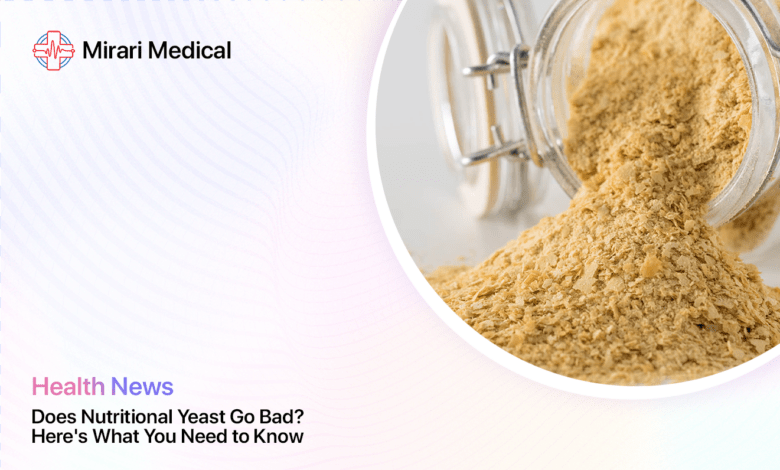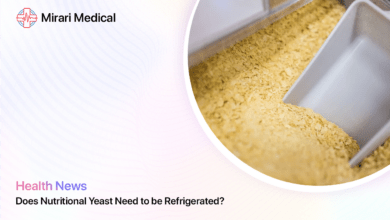Does Nutritional Yeast Go Bad? Here’s What You Need to Know

You may be interested
Nutritional yeast has surged in popularity in recent years as a tasty, nutrient-dense seasoning loved by vegans, vegetarians, and omnivores alike. This savory, cheese-like ingredient is a staple in many plant-based kitchens. But if you’ve had a jar of nutritional yeast sitting in your pantry for a while, you may be wondering – does nutritional yeast go bad? How long does it last and how can you tell if it’s still good to use?
In this in-depth article, we’ll cover everything you need to know about the shelf life of nutritional yeast. We’ll explain what nutritional yeast is, how it’s made, its impressive nutritional benefits, and most importantly – how to store it properly to maximize freshness. Whether you’re a nutritional yeast connoisseur or new to this tasty ingredient, read on to learn how to keep your nooch in tip-top shape.
What is Nutritional Yeast?
Before we dive into the shelf life of nutritional yeast, let’s clarify what it actually is. Nutritional yeast, affectionately known as “nooch” by fans, is an inactive form of Saccharomyces cerevisiae, the same species of yeast used in bread baking and beer brewing. However, unlike active yeast used for leavening, nutritional yeast is heated and dried to deactivate the yeast.
The resulting product is a flaky, yellow powder packed with nutrients. It has a savory, umami, almost cheese-like flavor that lends itself well to many dishes. Nutritional yeast is naturally dairy-free, soy-free, gluten-free, and low FODMAP, making it suitable for many special diets. It’s a popular ingredient in vegan cooking to mimic the flavor of cheese in sauces, dips, and as a seasoning.
How is Nutritional Yeast Made?
The process of making nutritional yeast starts with growing S. cerevisiae yeast in large tanks using a nutrient-rich growth medium, often derived from molasses or sugar beets. The yeast is allowed to ferment and multiply over several days under carefully controlled conditions.
Once mature, the yeast is harvested, washed, pasteurized, and dried, which deactivates it. The dried yeast is then crumbled into flakes or powdered. Some brands fortify their nutritional yeast with additional vitamins, especially vitamin B12. The nutritional yeast is then packaged into jars or bags and sold at health food stores and supermarkets.
What Are the Nutritional Benefits of Nutritional Yeast?
One of the main reasons nutritional yeast has gained such a following is its impressive nutritional profile. Here are some of the key nutritional benefits of this tasty seasoning:
1. Rich in B Vitamins
Nutritional yeast is an excellent source of B vitamins, which are essential for energy metabolism, nervous system function, and red blood cell production. Just 2 tablespoons of nutritional yeast contains:
- 9.6 mg Thiamine (640% DV)
- 9.7 mg Riboflavin (570% DV)
- 56 mg Niacin (280% DV)
- 9.6 mg Vitamin B6 (480% DV)
- 240% DV Folate
- 130% DV Vitamin B12 (in fortified varieties)
B12 is of particular importance to vegans and vegetarians, as it’s mainly found in animal products. Fortified nutritional yeast is one of the only reliable plant-based sources of B12.
2. Contains Essential Minerals
In addition to B vitamins, nutritional yeast provides several important minerals, including:
- 3 mg Iron (20% DV)
- 480 mg Potassium (10% DV)
- 24 mg Calcium (2% DV)
- 1.4 mg Zinc (10% DV)
- 120 mg Selenium (174% DV)
Selenium is an essential trace mineral with antioxidant properties that supports immune function and thyroid health.
3. Good Source of Protein
Nutritional yeast is approximately 50% protein by weight. A 2 tablespoon serving provides 8-10 grams of complete protein, meaning it contains all 9 essential amino acids the body needs. This makes it a great option for vegans and vegetarians looking to boost their protein intake.
The protein in nutritional yeast is also very digestible, with a Protein Digestibility Corrected Amino Acid Score (PDCAAS) of 0.91, comparable to milk and egg protein.
4. May Improve Immune Function
Some research suggests nutritional yeast may help support immune function. Beta-glucan, a type of fiber found in the cell walls of yeast, has been shown to have immune-stimulating effects.
One study found that taking 1/4 teaspoon of nutritional yeast daily reduced recurrence of chronic UTIs in patients. Another showed that beta-glucans from yeast had beneficial effects on immune responses in athletes after intense exercise. However, more research in humans is needed to confirm these potential benefits.
Does Nutritional Yeast Expire?
Now that we’ve covered the background on nutritional yeast, let’s get to the main question at hand – does nutritional yeast go bad? The simple answer is yes, eventually nutritional yeast will expire and lose its flavor and nutritional value. However, the good news is that it has a fairly long shelf life when stored properly.
What is the Shelf Life of Nutritional Yeast?
The shelf life of nutritional yeast can vary between brands, but in general, unopened nutritional yeast can last for up to two years in the pantry. Once opened, it’s best used within 3-6 months for optimal freshness, but can still be used up to a year later if stored properly in a cool, dark place.
Most nutritional yeast packaging will have a “best by” date stamped. This date indicates when the product is at its peak quality, not necessarily when it becomes unsafe to eat. Nutritional yeast may still be good for several months up to a year past this date if no signs of spoilage are present.
How to Tell if Nutritional Yeast Has Gone Bad
Although nutritional yeast has a good shelf life, it can still spoil eventually, especially if exposed to moisture or not stored properly. Here are the telltale signs that your nutritional yeast has gone bad:
- Mold: The most obvious sign of spoiled nutritional yeast is visible mold growth, which can appear as green, grey, or white fuzzy patches. If you see any mold, discard the yeast immediately.
- Off smell: Fresh nutritional yeast has a pleasant, cheesy aroma. If your nutritional yeast develops a sour, musty, or otherwise “off” smell, it has likely gone bad.
- Clumping: Nutritional yeast is very dry and should be loose and flaky. If it begins to clump up or feels moist, this is a sign that moisture has gotten in and it may be beginning to spoil. Some clumping is natural, but large, dense clumps are not normal.
- Change in color: A darkening in color from the typical bright yellow of fresh nutritional yeast to a more brown shade can indicate age and deterioration.
- Lack of flavor: A loss of the characteristic cheesy, umami flavor can also indicate the nutritional yeast is past its prime, even if no other signs of spoilage are present.
If your nutritional yeast looks, smells, and tastes normal, it is most likely safe to consume even if it is past the “best by” date. However, if you notice any of the above signs of spoilage, it’s best to err on the side of caution and throw it out.
How to Store Nutritional Yeast Properly
Proper storage is key to maintaining the quality and shelf life of your nutritional yeast. Here are some tips for keeping your nooch fresh:
- Keep it dry. Moisture is the enemy of nutritional yeast freshness. Always store in an airtight container or resealable bag.
- Store in a cool place. Heat can cause nutritional yeast to deteriorate faster. Aim to store it below 75°F (24°C) in a pantry, cabinet, or other dark place away from heat sources. Refrigeration is not necessary but can prolong shelf life.
- Avoid light. Exposure to light can degrade the nutrients in nutritional yeast over time. Store in an opaque container or place the original packaging in a dark bag or box.
- Use clean, dry utensils. Always use a clean, dry spoon or scoop to dispense nutritional yeast to avoid introducing moisture or contaminants that could lead to spoilage.
- Seal tightly. Make sure to seal the container tightly after each use to keep air and moisture out.
By following these simple storage guidelines, you can ensure your nutritional yeast stays fresh and flavorful for many months.
What are the Different Forms of Nutritional Yeast?
Nutritional yeast is available in several different forms to suit various needs and preferences:
1. Flakes
Nutritional yeast flakes are the most common form. The dried yeast is crumbled into small, irregular flakes that are easy to sprinkle on foods. Flakes are very versatile and can be used as a condiment, in cooking and baking, or blended into sauces and dressings.
2. Powder
Powdered nutritional yeast has a finer texture than flakes. It’s good for using in smoothies, shakes, and beverages where you want the yeast to blend in seamlessly without a grainy texture. Powdered yeast is also easier to use for making your own seasoning blends.
3. Tablets
Some brands offer nutritional yeast tablets as a dietary supplement. The tablets are usually fortified with additional B vitamins. While not as versatile as flakes or powder for cooking, tablets can be a convenient way to obtain the nutritional benefits of yeast.
Regardless of the form, make sure to store nutritional yeast appropriately in an airtight container to maintain freshness. The shelf life guidelines apply to all forms.
Can You Use Expired Nutritional Yeast?
If your nutritional yeast is past the “best by” date but shows no obvious signs of spoilage like mold, off-smells, or major clumping, it is likely still safe to eat. However, the quality, flavor, and nutritional value may have diminished.
Vitamins, especially B vitamins, are susceptible to degradation over time. A study found that B vitamin content of nutritional yeast decreased by 20-35% over 6 months of storage at room temperature. So while expired nutritional yeast won’t necessarily make you sick, it may not be as nutritious or tasty.
When in doubt, give the yeast a smell and small taste before using a lot of it. If it seems stale or flavorless, it’s probably best to replace it with a fresh batch for optimal quality.
What are Some Creative Ways to Use Nutritional Yeast?
Nutritional yeast is a very versatile ingredient that can add savory, umami flavor to many different dishes. Here are some tasty ways to use nutritional yeast:
- Sprinkle on popcorn or kale chips for a cheesy flavor without the dairy
- Stir into mashed potatoes, polenta, or grits
- Blend into cashew-based vegan cheese sauces or dips
- Mix into scrambled eggs or tofu scrambles
- Toss with roasted vegetables like broccoli, cauliflower, or Brussels sprouts
- Use as a seasoning for avocado toast or baked potatoes
- Add to soups, stews, or chilis for umami depth of flavor
- Incorporate into homemade salad dressings or pestos
- Use as a parmesan replacement to top pastas, salads, or pizzas
- Mix into breading for oven-baked “fried” foods like tofu nuggets or zucchini fries
The cheesy, savory taste of nutritional yeast can enhance so many foods. Don’t be afraid to experiment and find creative ways to use it in your cooking!
FAQs
How do you know if nutritional yeast has gone bad?
You can tell nutritional yeast has spoiled if you notice any visible mold growth, clumping, darkening in color, off smells, or a major loss of flavor. If any of these signs are present, discard the yeast.
When should you not eat nutritional yeast?
Avoid eating nutritional yeast if it is moldy, clumped, discolored, smells sour, or is flavorless, as this indicates it has gone bad. People with yeast sensitivities or allergies should also avoid nutritional yeast.
Does nutritional yeast need to be refrigerated?
No, nutritional yeast does not require refrigeration, but storing it in the fridge can help prolong its shelf life. The most important factors are keeping it dry, sealed, and away from light and heat.
Can I use 1 year old yeast?
If the yeast has been stored properly and shows no signs of spoilage, it is likely still safe to use up to a year after opening. However, the flavor and nutritional value may have declined compared to fresh yeast.
Can I use 2 year expired yeast?
Unopened nutritional yeast can last up to two years past the production date. If stored properly and no spoilage is evident, it is likely safe to use but may have diminished quality. Use your senses and best judgment.
Can 2 year old eat nutritional yeast?
Yes, nutritional yeast is safe for toddlers to eat in moderation as part of a balanced diet. It provides B vitamins, protein, and fiber. However, introduce new foods slowly and consult your pediatrician if you have any concerns.
Key Takeaways
- Nutritional yeast is an inactive form of yeast with a savory, cheesy flavor and impressive nutritional benefits including B vitamins, minerals, and complete protein.
- Nutritional yeast can expire, but has a shelf life of up to 2 years unopened or 1 year once opened if stored properly.
- Signs of spoiled nutritional yeast include mold, off smells, clumping, discoloration, and loss of flavor. Discard if any spoilage is evident.
- To maximize shelf life, store nutritional yeast in an airtight container in a cool, dry, dark place away from heat and moisture. Refrigeration can help but is not required.
- Nutritional yeast comes in flakes, powder, and tablet forms. The storage guidelines apply to all forms.
- Expired nutritional yeast is generally safe to eat if no signs of spoilage are present, but may have declined in flavor and nutritional value compared to fresh.
- Nutritional yeast is a versatile ingredient that can add cheesy, umami flavor to popcorn, potatoes, pasta, vegetables, sauces, dressings, and more.
By understanding the shelf life of nutritional yeast and how to store it properly, you can ensure you’re getting the most nutritional bang for your buck. Don’t let this tasty superfood go to waste – store it right and enjoy the savory goodness of nutritional yeast for months to come!
Your trusted source for health info, offering expert advice, news, and tips to stay healthy and informed.




